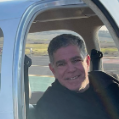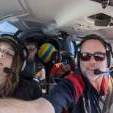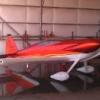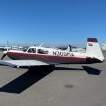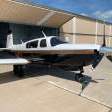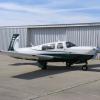-
Posts
2,450 -
Joined
-
Last visited
-
Days Won
31
donkaye last won the day on April 14
donkaye had the most liked content!
About donkaye
- Birthday December 29
Contact Methods
-
Website URL
http://www.donkaye.com
Profile Information
-
Gender
Male
-
Location
Santa Clara, California
-
Interests
Flying, Flight Instruction, Running, Clarinet
-
Reg #
N9148W
-
Model
M20M
-
Base
KSJC
Recent Profile Visitors
14,890 profile views
donkaye's Achievements
-
It bothers me that most people I do transition training with aren't comfortable with crosswind landings. They are actually the most fun landings. They're relatively easy if you just think "rudder for alignment", "aileron for drift", both done simultaneously. It's the "both done simultaneously" that creates the issue for most people.
-
For a pilot who hasn't done extensive crosswind training I completely agree. The speed was necessary to have the rudder control to align with the runway prior to touch down. Once touched down you can't rush the slowdown. You CANNOT be passive. You MUST be PIC and not let the plane fly you or you're going to be in trouble. If at any time you cannot hold the runway, you are right at the speed where you can add power and safely go around. For purposes of getting good at crosswinds or keeping up skills, whenever there are challenging winds in my area, I'm out there practicing. Most people aren't. For example in my area, Byron, O83, on the lee side of the Livermore Valley hills often has challenging crosswinds when no other place does. They have 2 runways, 23 and 30. Serious winds often come off the mountain at 90° to RWY 30. Most people will land on 23. I'm landing on 30 where, when the wind is blowing, it's often 20G28 direct crosswind. Good practice.
-
While I'm a proponent of the 3° slope stabilized approach, this is the one instance when you need to come in flat and "grease" the landing on 3 wheels. That's why I say it is not for the inexperienced pilot because you have to touch down with no vertical motion and control the rate of slow down such that if you can't hold the runway, you initiate a go around immediately.
-
Landing in gusty conditions with a strong headwind component is one thing, landing in gusty crosswind conditions with no headwind component is quite another. In the "Proficient Pilot" by Barry Schiff he discusses one method that has worked well for him in a Piper. I prefer another that I use but haven't seen published anywhere. It isn't for anyone unexperienced in large crosswinds or on short runways. Using that method I have landed in direct crosswinds in excess of 40 knots with no headwind component. It does involve flying the airplane onto the runway at speeds in excess of 100 knots and gradually slowing the plane down, with more and more aileron added into the wind. At any time if directional control is unable to be maintained, then full power can be added and a go around immediately initiated. Except for several go arounds at Oceano, L52, a 2,360 foot runway when there was a strong gusty crosswind, I have not had to go around using this technique. I went around twice and told myself that if another go around was required, it was time to go to another airport. The winds cooperated the third time and I was able to make the landing. However, never "force" a landing.
-
G5 and MVP-50 goes on with the master.
-

Flying with oxygen : recommended also for 20.000 plus feet?
donkaye replied to Raffi's topic in General Mooney Talk
I really wish I could have gotten the MH O2D2 to work in my airplane. The most O2 Saturation I could get with it even on the highest setting was 93% and I need at least 96% to feel normal. My problem very likely was the altitude compensating regulator that is included in the Bravo. I had to send the unit back. O2 is reasonably inexpensive so I turn it on above 7,000 feet during the day, and from the ground up at night, since night vision is greatly effected by lack of O2. -
donkaye started following Useful Load 89/90 Bravos 168LB increase , Switch Positions , AOPA drops VREF and 3 others
-
I gave quite a bit of thought to my arrangement. Lower left in order, Master, Alternator, Display, Avionics. They go on immediately at startup. I then grouped the lights in two rows right in front of me. The landing, taxi and recognition lights are on the top row. Each operates on its own. The lower three in order are the Nav, Strobe and Pulse lights. At night the Nav lights go on and when on the runway at all times the Strobe and Pulse lights go on. The Pulse Lights pulse alternately the left Recognition light and right Taxi light and vise versa. They take precedence over the Recognition lights. To the right of the lights is a row of miscellaneous items, Boost Pump, Pitot Heat, Prop Deice, and the Master LHS switch. The LHS switch was the old pitch trim switch for the KFC 150. I have found this placement has worked well for me.
-
Just for the heck of it I looked at the Bravos for sale on Controller. There wasn't one I would even begin to consider. A lot of "cheap" people who upgraded their airplane in a manner not befitting the capability of the Bravo. Most prices were ridiculous for the crappy avionics in the planes.
-
Approximately 475 students x 50 landings on average = 23,750 landings with students over 32 years. Then about 2,000 landings in 4,523 hours in my airplane. Total landings made = 25,750 to a good approximation. Then one landing video made. (https://donkaye.com/landing-video} No arrogance intended, only that I've done so many landings and experienced many ways they can go wrong, that I've learned over 56 years of flying my preferred way to land and teach landings. 50-100 feet is too high to take your eyes off the airspeed indicator. Assuming I'm reading the next highlighted in red sentence correctly, this implies "dropping" into ground effect and holding the plane off until it is ready to land. While this techniques may give a good landing, it will also extend the landing many hundreds of feet, since the holdoff is occurring in ground effect. The best landings are made when attention is paid to BOTH airspeed AND slope. When practical (no obstructions), the slope should be 3° for a comfortable descent rate and an airspeed of 1.3 VSo for the aircraft weight should be maintained. The slope and airspeed should be maintained to about 10 feet agl, where in smooth no wind conditions power should be smoothly withdrawn to idle and the flare should be begun at such rate that the nose of the plane transitions from a 3° nose down attitude to the landing attitude of about 8° where the wheels are "rolled" on with the stall warning horn going off. As the aircraft descends from 10 feet at a decreasing rate of descent, at least 2 stripes on a centerline runway should always be in view--all the way to touchdown. The nose of the airplane should NEVER be so high as to obstruct the runway. The "art" of the landing is practicing the rate of flare to dissipate ALMOST all, but not ALL, the energy at touchdown. This allows for a controlled touchdown with minimum runway used.
-
I think it is important what data you see in the Blue data blocks. I like having the "local time" and the 'in air time". I have the "total time" that goes in my logbook read off of the GTN 650. I record the "in air time" on a spreadsheet for future reference. Also important is the cooling rate of the fastest cooling cylinder, since this prevents shock cooling if attention is paid to it. Then "Is the gear down of not?" Just one more indication of it. And then, of course, the TIT for turbocharged engines is important along with fuel remaining.
-
My mentor instructor, Bob Goldin, once said that the difference between the normal private pilot and a pilot with an ATP was the ATP pilot flew for the passenger--even if you are the passenger. That means fly with "grace" and "smoothness". Passengers for the most part don't like steep turns. They feel more comfortable if flying is like riding in a car. That means shallow turns. So, I teach flying the pattern with shallow turns. I'd rather a student end up lined up early and ease their way to the center line than to overshoot final. This is especially true with parallel runways. Shallow early turns => Less likely a Cross Controlled Stall in my opinion. Of course you all know that you can get your ATP in your airplane. That's how I got my original ATP, in my airplane.
-
Installing the MVP-50 was one of the best decisions I made with my upgrade. In my opinion it is the best stand alone engine monitor out there. Yes, JPI is worthy, but the MVP-50 has more versatility for my usage. I've attached my worksheet to show how I set mine up. With the M20C you won't have TIT. The small box between the MP and RPM turns red and shows gear not down, if the gear is not down below a certain MP. There is an extra register on the fuel page that displays trip totals and resets on engine shutdown that I find extremely useful. There is the ability to set 2 automatic fuel levels when adding fuel; in my case 89 gals to the bottom of the neck and 100 gals topped off. There are too many other benefits of the unit to mention in this small space. At the time I upgraded my display the cost was a little over $1,400. If you are buying new, you will get the new display. The functionality also increased with the upgrade, in particular the ability to see time to destination instead of time to waypoint--to me a MAjOR improvement for trip planning. and execution. MVP-50 Worksheet 8:23:2013.pdf
-
Totally subjective at this point, but if the base leg did have a 10 knot tailwind, then with some anxiousness to get on the ground, an overshoot of final (and from the track that looks to be the case) could have caused the classic cross controlled base to final stall? Just hypothesizing with no basis in fact... Obviously, we need the final accident report to shed more light on the situation. The pilot seemed pretty calm initially about a simple return for landing and closing the door.
-
I'm Serial #106 and I don't have that limitation. The dual puck brakes started with Serial #107. I missed it by one but added them later ($$$). Both for cost and utility I should have added them a lot sooner. Edited: It looks like an issue only up thru Serial #52.


